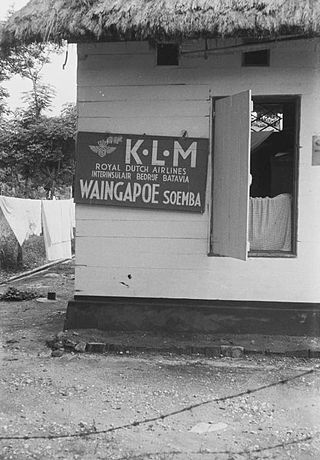KLM Interinsulair Bedrijf
Defunct Dutch East Indies airline of KLM From Wikipedia, the free encyclopedia
Koninklijke Luchtvaart Maatschappij Interinsulair Bedrijf Batavia (KLM Interinsulair Bedrijf or simply KLM-IIB; lit. 'Royal Dutch Interinsular Airline Services Batavia') was an airline based in the Dutch East Indies (present-day Indonesia) and the predecessor to Garuda Indonesia.
| |||||||
| Founded | 1 August 1947 | ||||||
|---|---|---|---|---|---|---|---|
| Ceased operations | 28 December 1949 (2 years, 4 months and 27 days) | ||||||
| Fleet size | 10+ | ||||||
| Destinations | Domestic, Singapore, British Malaya and Philippines | ||||||
| Parent company | KLM | ||||||
| Headquarters | Java, Dutch East Indies | ||||||

History
KLM Interinsulair Bedrijf (KLM-IIB) was founded on 1 August 1947 at Kemayoran Airport as a KLM subsidiary (due to the dissolution of Koninklijke Nederlandsch-Indische Luchtvaart Maatschappij (KNILM)),[1] and all of the aircraft in KNILM fleet were later transferred to KLM-IIB. They also received twenty Dakota aircraft, previously operated by Koninklijk Nederlands Indisch Leger (KNIL).[2]
Based in Java,[2] their destinations consisted of domestic routes (within Indonesia) and also international routes (such as Singapore; Penang, British Malaya; and Manila, Philippines),[3] operated by several Dakotas and nine Consolidated PBY Catalina amphibious aircraft.[2]

Nationalization by Indonesian government
On 28 December 1949, KLM-IIB was nationalized by the Indonesian government, as agreed by both the Indonesian and Dutch governments during the 1949 Dutch-Indonesian Round Table Conference. Upon the nationalization, the airline was renamed as Garuda Indonesia, now the flag carrier of Indonesia, and it remains to this day.[2]
Fleet
Accidents and incidents


- On 10 February 1948, Flight 947, a Douglas C-47B (PK-REA), lost control and crashed near Padalarang while attempting to return to Bandung following an engine failure, killing all 19 on board.[4][5]
- On 8 March 1948, a Consolidated PBY Catalina (PK-CTC) was damaged during takeoff at Poso, Sulawesi and sank, due to "a misunderstanding about the starting procedure to be followed between captain [C.L. van Kooij] and 2nd pilot [M.G. Nicolai] crashed during takeoff." None of the nine crew and passengers were injured. It was damaged beyond repair. It "took all the luggage to the seabed."[6]
References
Wikiwand - on
Seamless Wikipedia browsing. On steroids.
